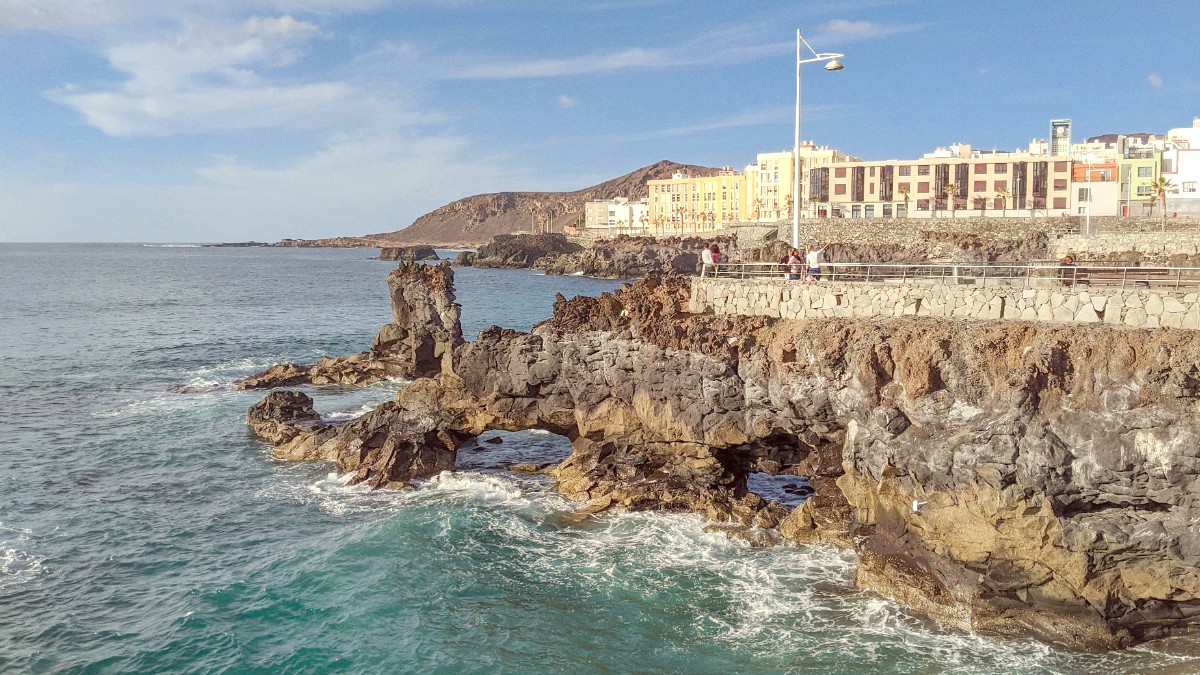
Gran Canaria, Canary Islands
Imagine waking to the sound of ocean waves, spending your morning exploring historic cobblestone streets, and your afternoon relaxing on a city beach. Later, you enjoy fresh seafood as the sun sets over the Atlantic. This is a typical day in Las Palmas de Gran Canaria, a city with diverse experiences. It features a blend of cultural richness, outdoor activities, and a laid-back island pace. Seeking adventure, relaxation, or cultural discovery, Las Palmas greets you with its unique atmosphere and constant spring-like weather.
Las Palmas' geography, with its dual coastlines and the isthmus, forms a strategic position. This setting was to its historic development as a maritime stopover and continues to shape its identity. The varying elevation from coast to hillsides provides sweeping panoramas.
Atlantic breezes consistently temper the city's temperatures. This creates its mild climate. The volcanic La Isleta peninsula creates a rugged northern edge. It has hiking paths and wilder beaches like El Confital, a contrast to the urban Las Canteras.
Las Palmas de Gran Canaria is a rich and layered history. It is deeply tied to global exploration and trade. The city's founding on June 24, 1478, by Juan Rejón, a Castilian captain, marked the start of the Castilian conquest of the Canary Islands. The conquest ended shortly after. Its location was picked for strategic position, a safe harbor and a convenient stopping point for voyages across the Atlantic.
Its most famous historical connection involves Christopher Columbus. The city was a required stopover for Columbus on his initial voyages to the Americas. In 1492, before his first transatlantic journey, Columbus visited Gran Canaria. He repaired one of his ships, the Pinta, and gathered supplies. He stayed in a house in the Vegueta district. Today, the Casa de Colón (Columbus House) museum commemorates this fact. This visit, and subsequent ones, cemented Las Palmas' role as a link between the Old and New Worlds. The city became a hub for trade, exploration, and the exchange of cultures and goods.
City founded by Juan Rejón, beginning the Castilian conquest.
Christopher Columbus makes his first stopover before his transatlantic voyage.
Sir Francis Drake's attempt to attack the city is repelled.
Dutch attack by Pieter van der Does is successfully defended.
Evolved into a cosmopolitan center due to its role as a major port.
The city's strategic role brought diverse populations and influences. This blended Spanish traditions with elements from Africa and Latin America. This cultural mix is visible in the city's architecture, cuisine, and local customs.
The historic Vegueta district, the oldest part of the city, retains much of its original colonial architecture. Its cobblestone streets, charming plazas, and traditional Canarian balconies are prominent. This area links to the city's past, inviting visitors to walk through centuries of history.
As a co-capital of the Canary Islands (sharing this status with Santa Cruz de Tenerife), Las Palmas maintains its administrative and economic importance. It continues to be a melting pot of cultures and a gateway to the wider archipelago.
View of Las Palmas de Gran Canaria, showing the blend of city, beach, and port.
Las Palmas de Gran Canaria offers a memorable experience for travelers. It is a city of contrasts and harmonious blends.
It combines the vibrancy of a capital city with the relaxed allure of an island escape. It holds something for every traveler, from history buffs and beach enthusiasts to food lovers and outdoor adventurers.
Consistently mild temperatures year-round, making it a destination suitable regardless of season.
Playa de Las Canteras is a lively hub for swimming, surfing, and strolls along its long promenade.
Food scene blends traditional Canarian flavors with international influences.
The Vegueta district, the city's original nucleus, transports visitors back in time. Its narrow, cobblestone streets reveal colonial-era architecture, historic plazas, and important landmarks.